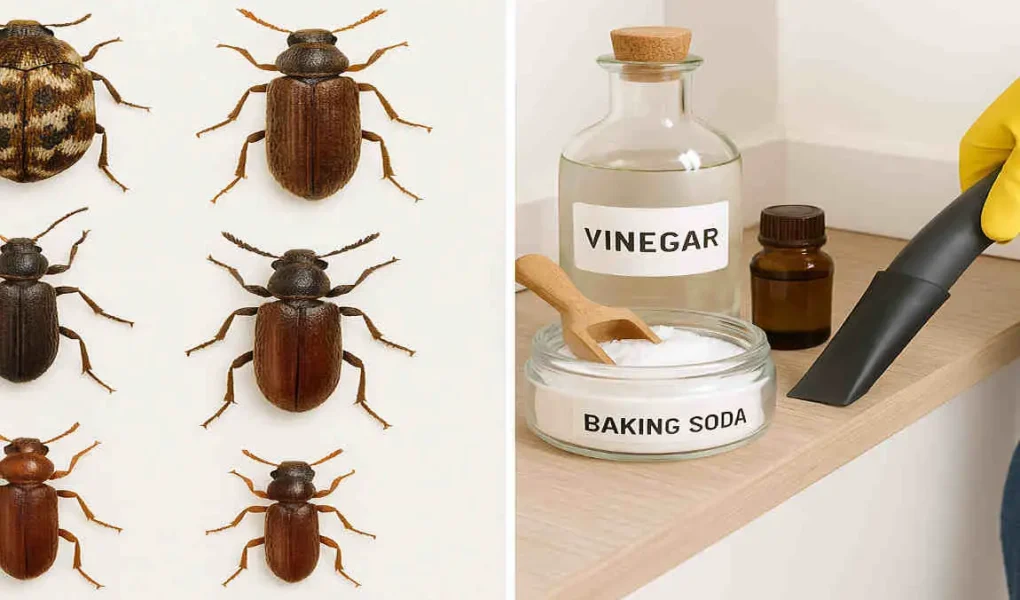Hey there, reader! Have you ever walked into your kitchen or living room and spotted a tiny beetle scurrying across the floor? It’s one of those moments that makes you stop and think, “Why are there beetles in my house?” You’re not alone inean this. Many homeowners face this pesky issue, and it can feel downright frustrating. But don’t worry—I’m here to help you sort it out.
We’ll talk about what draws them inside, how to spot them, and most importantly, some solid cleaning tips for beetles to get rid of them. Whether you’re dealing with a minor sighting or a full-blown beetle infestation, understanding the “why” is the first step to taking back your space.
Why Are There Beetles in My House?

You might be scratching your head, wondering why these little critters chose your place. Let’s break it down. Beetles invade homes for all sorts of reasons, and knowing them helps you fight back. In this section, we’ll look at the common types, the “why” behind their visits, and the telltale signs of trouble.
Types of Beetles Commonly Found Indoors
First off, not all beetles are the same. Some are harmless wanderers, while others can cause real damage. Let’s meet the usual suspects that might show up in your house.
Take carpet beetles, for example. These minor, rounded bugs enjoy munching on fabrics, including carpets, curtains, and even your favorite throw pillows. If you’re into home decor, spotting one of these can be a nightmare—they’re tiny, often black or spotted, and they blend right in.
Then there are weevils. You know, those long-snouted beetles that raid your pantry? They target stored grains, flour, and rice. I’ve seen them in kitchens where food isn’t sealed tight, turning a simple snack into a cleanup chore.
Don’t forget spider beetles. These creatures resemble spiders with their long legs and humped backs. They thrive in dark, dusty spots, feeding on crumbs or old papers. In older homes, they’re a common find.
Ladybugs might sound cute, but they’re actually ladybird beetles. They cluster indoors during colder months, seeking warmth. While they’re mostly beneficial outside, a bunch inside can stain walls and fabrics.
And if you’re in a wooded area, stag beetles could appear. These large, jawed beetles are more outdoor types, but they might wander in through open doors. Regional differences matter—check what’s common in your area.
Reasons Beetles Invade Homes
Okay, now let’s talk about why they’re here in the first place. Beetles don’t just pop in for fun—they’re looking for something your home provides.
Food is a big draw. Think about those open bags of pet food or crumbs under the couch. Beetles like weevils zero in on stored grains, while carpet beetles feast on wool or silk items. If your pantry isn’t organized, it’s like rolling out the welcome mat.
Seasonal shifts also play a role. When temperatures drop or humidity rises, beetles seek shelter indoors. In the fall, you might notice more activity as they escape the cold. Hot, humid summers? That pushes them inside for cooler spots.
Entry points are sneaky culprits. Cracks in walls, gaps around windows, or even vents let them slip through. I once helped a friend seal a tiny door gap, and poof—no more beetles!
Moisture and decaying matter also attract them. Leaky pipes create damp areas where beetles breed. Decaying plants or wood piles outside can push them toward your dry, cozy interior.
Lastly, outdoor conditions matter. Overgrown yards or nearby fields can attract beetles to your area. If your home backs onto nature, you’re more at risk. What about your place? Take a quick look around—spotting these reasons early can save you a lot of headaches.
Signs of Beetle Infestation
Spotting beetles in my house isn’t always apparent at first. But there are clues if you know where to look.
The most straightforward sign? Seeing the beetles themselves. If you spot one or two, it might be a fluke. But clusters? That’s a red flag for infestation.
Damage is another giveaway. Check your clothes for tiny holes—carpet beetles love natural fibers. In the kitchen, look for chewed packaging or webbing in flour.
Beetle babies, or larvae, are sneaky. They look like tiny worms or grubs and hide in dark corners. Shed skins? Those papery casings mean they’re molting and multiplying.
Listen up, reader: If you notice a musty smell or unusual dust, investigate the source. These signs can sneak up on you, especially in decor-heavy rooms where beetles hide in rugs or behind pictures.
Catching these early prevents bigger issues. Have you checked your closets lately? A quick inspection could reveal a hidden problem before it ruins your home’s charm.
How Do Beetles Affect Your Home and Health?
Now that we’ve covered the “why,” let’s chat about the “what”—as in, what happens if you ignore those beetles in my house? It’s not just annoying; it can hit your home and health in real ways. We’ll break this down so you see why action matters.
Beetles can wreck your stuff. Carpet beetles munch through fabrics, leaving holes in curtains, upholstery, and even that vintage rug you love for home decor. Weevils spoil food, contaminating pantries and forcing you to toss out staples. Wood-boring types? They tunnel into furniture, weakening structures over time.
Health-wise, it’s no joke. Some people experience allergic reactions to beetle hairs or droppings, which can manifest as itchy skin or breathing issues. Contaminated food from weevils could lead to stomach woes if eaten unknowingly.
Psychologically, it’s draining. Who wants to relax in a home that feels invaded? That constant worry can be stressful, especially if you’re preparing a house for sale as a real estate agent. A beetle infestation might scare off buyers, dropping property value.
Timely intervention is crucial. Don’t let it escalate—address it now to keep your space safe and stylish. Imagine hosting friends without that nagging fear. Sounds better, right?
How to Identify the Type of Beetle in Your House
Identification is your secret weapon against beetles in my house. Without knowing what you’re dealing with, removal gets tricky. Let’s make this simple—I’ll guide you through visuals, behaviors, tools, and when to seek help.
Behavior clues in too. Ladybugs cluster on sunny windows, seeking light. Stag beetles are nocturnal, hiding by day. Watch where they hang out—pantry for weevils, fabrics for carpet types.
Grab some tools: A flashlight highlights dark corners, and a magnifier shows details like spots or legs. Snap a photo and compare online—resources like pest guides are gold.
If it’s overwhelming, consider hiring a professional to help. They have expertise for tricky cases, especially in large homes. Reader, try identifying one yourself—what do you see? It empowers you to act fast.
Effective Cleaning and Removal Tips for Beetles

Alright, let’s roll up our sleeves! This is where we tackle how to get rid of beetles with practical cleaning tips for eliminating these pests. We’ll go step-by-step, cover natural methods, chemicals, and prevention routines. Get ready to reclaim your home.
Step-by-Step Cleaning Guide
Cleaning starts with the basics. Declutter first—remove piles of clothes or papers where beetles hide. Vacuum thoroughly, paying special attention to carpets, crevices, and upholstery. Do this weekly to suck up eggs and larvae.
Next, target infested spots. Use a mild soap solution to wipe down shelves and floors. For fabrics, wash in hot water. Dispose of vacuum bags outside immediately to avoid re-infestation.
Natural and DIY Beetle Removal Methods
Love eco-friendly options? Try diatomaceous earth—it’s a natural powder that dehydrates beetles. Sprinkle it in problem areas and leave it for a few days.
Essential oils work wonders, too. Mix lavender or peppermint with water in a spray bottle. Beetles hate the scent, so spritz entry points. It’s safe and smells great!
Here’s a quick bulleted list of DIY tips:
- Seal food tightly: Use airtight containers to prevent weevils from infesting your food.
- Freeze infested items: Pop fabrics or grains in the freezer for 48 hours to kill larvae.
- Vinegar wipes: Clean surfaces with vinegar to deter moisture-loving types.
Chemical Treatments
If natural methods aren’t enough, chemicals can provide additional support. Choose indoor-safe insecticides labeled for beetles. Spray cracks and baseboards, but always follow instructions.
Precautions matter: Ventilate the area, keep pets away, and wear gloves. Apply in the evening when beetles are active.
Preventive Cleaning Tips
Keep things dry—fix leaks and use dehumidifiers to prevent moisture buildup. Store fabrics in sealed bins, especially if you’re into home decor projects.
For a handy reference, here’s a table summarizing cleaning methods:
Method Type Description Best For Pros Cons
Vacuuming Suck up beetles and eggs with a strong vacuum. All areas, especially carpets. Quick and non-toxic. Needs repetition.
Diatomaceous Earth Powder that dries out insects. Floors and crevices. Natural and cheap. Messy if overused.
Essential Oils: Spray with a lavender or peppermint mix. Entry points and fabrics. Pleasant smell, safe for homes. May need reapplication.
Insecticides: Chemical sprays for challenging cases. Heavy infestations. Fast results. Potential health risks if misused.
Traps: Homemade jars with bait. Kitchens and pantries. Easy to make. Not for large areas.
See how these fit your needs? Mix and match for the best results.
How to Prevent Beetles from Coming Back
You’ve cleaned house them out—great job! But prevention keeps them away for good. Let’s focus on sealing up, making outdoor tweaks, and monitoring to prevent beetles from entering indoors.
Seal entry points: Caulk cracks, install door sweeps, and screen vents to prevent drafts from entering your home. It’s like fortifying your castle.
Outdoors, trim bushes and clear debris. Avoid wood piles near the house—they’re beetle magnets.
Use insect screens on windows and keep doors closed to prevent insects from entering your home. Periodic inspections? Do a monthly walkthrough, flashlight in hand.




